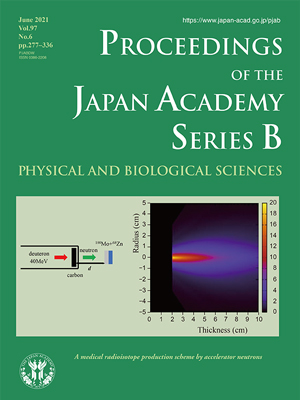About the Cover
Vol. 97 No. 6 (2021)
Radioisotopes (RIs) in the form of radiopharmaceuticals are being used in diagnostic imaging and radiotherapy. 99mTc with a half-life (T1/2 = 6 h) obtained from 99Mo (T1/2 = 66 h) is the most widely used radioisotope in diagnosis worldwide, about 0.9 million diagnoses every year in Japan; 131I (T1/2 = 8.02 d) has been used to treat thyroid cancer. Japan imports all of its required 99Mo several times per week, and also 131I. A constant supply of 99Mo is a key issue for ensuring the routine application of 99mTc. Most of 99Mo is produced in several aging research reactors around the world, but the supply chain of 99Mo is vulnerable, which often causes a shortage of 99Mo worldwide. Hence, the development of alternative schemes, although they have challenges of lower reaction rates and lower specific activity of 99Mo, is indispensable for the reliable production of 99Mo.
Yasuki Nagai (see the article in this issue pp. 292-323) has proposed a new production scheme for 99Mo using accelerator neutrons; neutrons that have a high neutron flux of 2.5×1014 n/s with a most probable energy of 14 MeV are generated by bombarding a carbon target with 40-50 MeV, 2 mA deuterons. 99Mo is produced by irradiating a 100Mo sample with the neutrons. A longer traveling range of neutrons (no charge) in matter allows the use of a thick sample, and the neutron energy is suitable for producing carrier-free RIs, including therapeutic ones, such as 64Cu (T1/2 = 12.7 h) and 67Cu (T1/2 = 62 h), with a minimum level of impurity RIs. The cover figure (left) shows a schematic of producing accelerator neutrons and RIs. Most accelerator neutrons are emitted in the forward-direction with respect to the deuteron beam direction; this allows the use of an enriched 100Mo sample with a 4-5 cm thick small surface area for producing 99Mo by fully utilizing the generated neutrons (right figure). Nagai and his colleagues have shown that they can solve the problem of a lower reaction rate by using such accelerator neutrons. Further, they challenged the problem of a lower specific activity by employing a thermos-chromatography separation method, and solved it by measuring the diffusion coefficient of 99mTc in a molten MoO3 sample and a separation efficiency of 99mTc from 99Mo using a home-made electric furnace. The furnace played an essential role to solve the problem. These fundamental studies have led them to a proposal, named GRAND, for a prototype facility that consists of a cyclotron with a 50 MeV, 2 mA deuteron beam intensity to secure a constant supply of 99Mo for domestic use and to promote the use of therapeutic RIs.
Toshimitsu Yamazaki
Member of the Japan Academy




